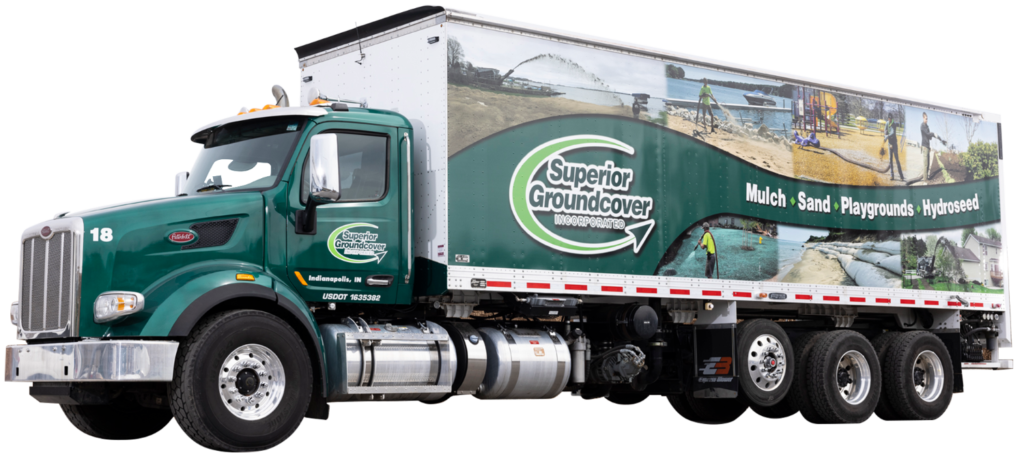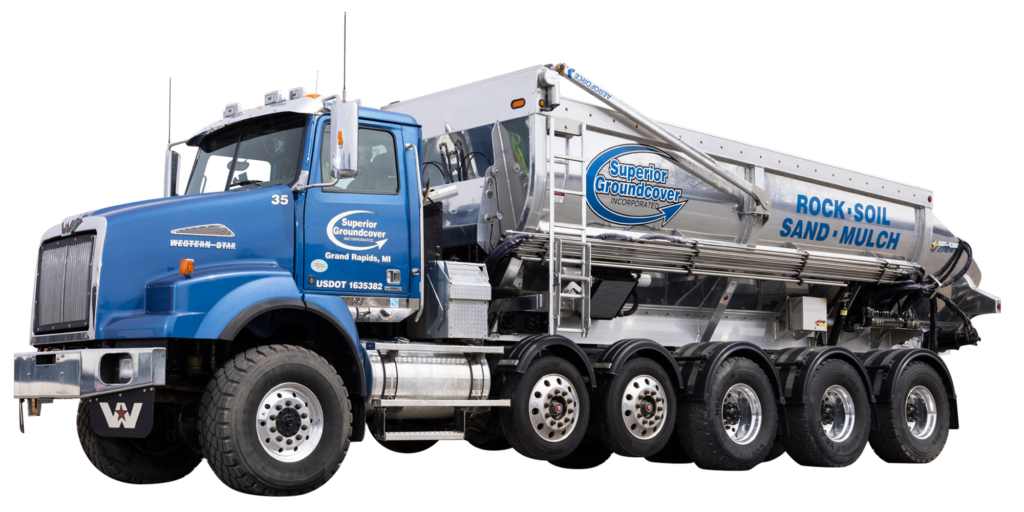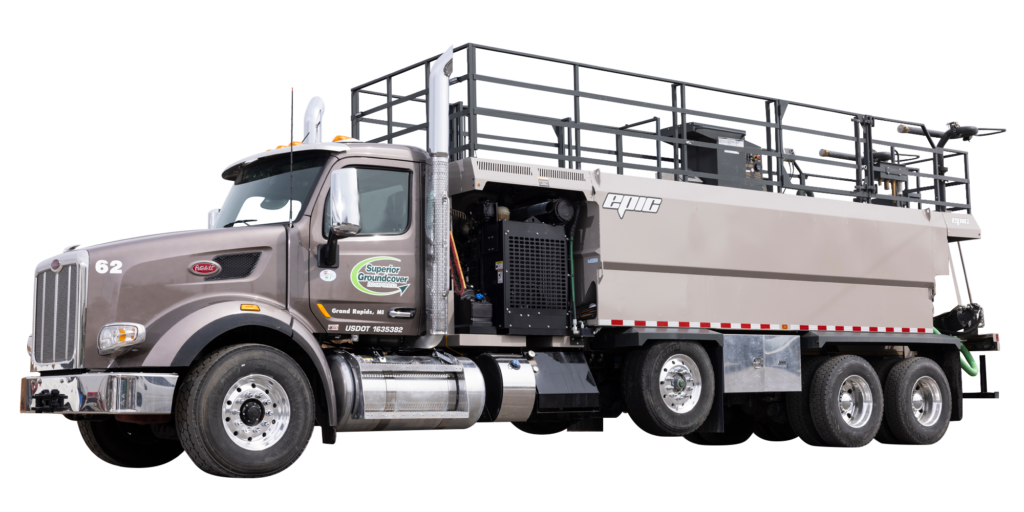Shoreline erosion affects both the Great Lakes and inland lakes in Michigan. When shoreline erosion happens, major problems arise for property owners as well as the lake environment. Sedimentation alters the ecosystem in lakes in ways like: removing or damaging plants that the fish need for food and spawning; bringing pollutants from the shore/soil into the water; and causing the water to lose clarity, which in turn, makes feeding difficult for the fish.
“It is estimated that over one billion tons of sediment pollute the waters of the United States each year.” — Watershed Council, Understanding, Living With, and Controlling Shoreline Erosion: A Guidebook for Shoreline Property Owners Third Edition (The Tip of the Mitt Watershed Council, 2019)
Shoreline Erosion also creates issues for property owners, aside from hurting the lake environment. Property value is extremely dependent on controlling shoreline erosion. “One of the most obvious impacts, and perhaps that of greatest concern to many shoreline property owners, is the loss of valuable waterfront property. Given the high value of shoreline property, recession of just one foot of shore along a 100-foot lot can represent a loss of more than $9,000 on a cost-per-square-foot basis. This does not take into account the potential damage to, or loss of, near- shore buildings and other structures,” according to WatershedCouncil.org (Understanding, Living With, and Controlling Shoreline Erosion: A Guidebook for Shoreline Property Owners Third Edition).
In recent years, we’ve seen beaches all but disappearing. When property owners try to control shoreline erosion with the wrong methods, they can actually make the problems worse for themselves and their neighbors. In this article, we’re going to walk you through some of the main causes of shoreline erosion, what’s happening currently with shoreline erosion and the Great Lakes, how to prevent shoreline erosion, and what steps you can take to fix it the right way.
What are the Causes of Shoreline Erosion?
There are three main factors that lead to shoreline erosion. These are:
- Natural Terrestrial (Land) Forces
- Natural Aquatic (Water) Forces
- Human Influences
Natural Causes of Erosion
Many natural forces can lead to shoreline erosion. These include things like wind erosion, frost action, soil creep, and slumping. These are all issues that can be (mostly) addressed by properly landscaping your property under the advisement of a professional. When landscaping your property, keep in mind groundwater movement, wind, and temperature changes. We have several available resources on proper drainage methods.
Water is an extremely powerful source of erosion, and — depending on where you live — can come in many different forms. In Michigan, erosion can happen because of waves, storms, and changing water levels. Here are some of the aquatic forces that lead to erosion:
- Splash: Precipitation and storm water hitting loose soil cause heavy displacement depending on the slope of the property.
- Waves: Waves caused by boats or natural causes can displace loose soil when the soil composition isn’t right for the area and natural vegetation has been removed.
- Ice: When lakes freeze and then melt, sheets of ice are pushed up onto the shore. This is occurring more and more frequently as water levels rise.
- Storm Water: As storm water moves over loose soil, layers of the soil are removed/displaced in “sheets” leading to something called “Sheet Erosion.”
Human Influences on Shoreline Erosion
Human influences also cause shoreline erosion to happen. This is often referred to as “accelerated erosion” which happens much faster than natural erosion and is much more challenging to reverse. Sometimes, people who are trying to help control shoreline erosion are actually causing much more damage in the process.
According to the Watershed Council’s guidebook on shoreline erosion: Understanding, Living With, and Controlling Shoreline Erosion: A Guidebook for Shoreline Property Owners Third Edition, “many erosion control projects which have been constructed are either inappropriate or ineffective…” (The Tip of the Mitt Watershed Council, 2019).
Changing the elevation of a property using level control structures raises lake levels so that the shore is more directly impacted by waves and other natural forces.
Removing vegetation in order to create more visibility and access to the water not only destroys many natural habitats, but gets rid of the natural erosion control that plants and tree roots offer.
When people install impervious surfaces like driveways or structures, that surface area is now unable to absorb water from precipitation. This precipitation will therefore begin to collect in pools and cause erosion instead of absorbing into the soil naturally.
According to the Michigan Shoreline Partnership, the “two most destructive actions” that lead to shoreline erosion are removing natural vegetation and building seawalls or “hardening of the shoreline” in any way (Michigan Natural Shoreline Partnership, 2019).
-
Vegetation Removal
Plant roots create a natural barrier to shoreline erosion by protecting the soil and holding it in place. When property owners remove this vegetation and replace it with a grass lawn, they are destroying that barrier and causing accelerated erosion to occur. Aquatic plant removal can have the same effect. Shallow lakes tend to have more aquatic plants near the shore. These plants help protect the shoreline from erosion by reducing a wave’s energy before it comes in contact with the shore. When too many aquatic plants are removed, the ecosystem in the lake is not only damaged, but the full erosive force of waves is able to hit the shoreline and cause damage there too.
-
How Seawalls Make Erosion Worse
A “seawall” is any type of hard “wall” installed along the shore that is intended to prevent waves from hitting the shore. Seawalls can be constructed from materials like concrete, rock, or wood. When property owners install these walls hoping to control the erosion of their beaches, they actually cause more problems. Seawalls create barriers for wildlife like turtles, which disturbs the ecosystem. Ecosystem disturbances are not only issues for wildlife, but can cause the entire lake to have issues and become less enjoyable for lakefront residents too.
Seawalls also prevent the absorption of wave energy. When a wave hits a wall — rather than vegetation or soil — the energy is not absorbed, and therefore, is directed elsewhere. Usually, it goes downward toward the lake bottom, where it “scoops” out the soil there. This event is called “scour.” Scouring leads to more habitat loss AND makes the lake deeper until the seawall is no longer viable and the water undercuts it. Scouring also makes the water cloudy, algae-filled, and all together much less pleasant for lake life and people.
Not only do seawalls mess with the lake, but they also mess with neighbors. A phenomena called “wave flanking” happens when a wave hits a seawall and is directed sideways instead of downwards. The wave redirects toward neighboring property which causes erosion damage to those beaches. You can see how this causes somewhat of a domino effect. When one seawall is installed, neighboring seawalls are required to handle the wave flanking, and a vicious and unnatural cycle continues to wreak havoc on the lakes.
To see wave flanking in action, check out this video made by the Watershed Council here.
Great Lakes Shoreline Erosion
Inland lakes, rivers, and streams are not the only ones affected by natural and accelerated erosion. Our Great Lakes are also suffering from shoreline erosion. Here in Michigan we are lucky enough to have over 3,000 miles of beautiful shoreline along the Great Lakes. Each year, we notice a little bit more of these beaches are gone. This is a natural occurrence that happens because lakes are not static, they are constantly changing environments. While this type of erosion is natural, it can cause issues for property owners whose property value can be destroyed after one powerful storm.
Overview and History of Beaches and Erosion
As most of us know, we can thank ancient glaciers for carving out our Great Lakes, but it didn’t all happen at once. There were many glacial advances that slowly sculpted our stunning shores. The different movements of these glaciers can been seen in the exposed dunes and bluffs along the water. Like the everchanging Great Lakes, these shoreline features are living, and differ from season to season. Natural erosion is one reason for these changes. The different glacial movements overtime led to different soil types in different regions. In the north, for example, the shore is composed mainly of rock vs. sand because the glacier was very erosive and removed all other sand/soil leaving only erosion-resistant rock. Overtime, even these strong rocks can be displaced and worn down by repetitive waves.
Throughout their existence, the Great Lakes have withstood rapid and extreme changes that have altered our beaches. Temperature changes can bring the lakes from entirely frozen to swimmable in a matter of months. As discussed above, ice forming, melting and reforming can lead to natural erosion. Lake levels rise and fall throughout the years due to storms covering and uncovering beaches. Strong winds from weather systems have added contributed to eroding shores. Human influences like construction, vegetation removal, boating, and more have also altered the landscape as well as wave and wind patterns that contribute to erosion.
All of these factors have caused our beaches to look dramatically different decade to decade and even year to year. “On at least five occasions, Lakes Michigan and Huron rose or fell more than three feet (one meter) in about a year and a half. In about the same interval, Lake Erie rose nearly three feet in 1991-1993 and dropped about three feet in 1930-1931 and 1986-1988. In 1930-1931, Lake St. Clair dropped 3.8 feet (1.2 meters) in eight months.” (Michigan.gov, 2019)
Lake Michigan Shoreline Erosion — What’s happening currently?
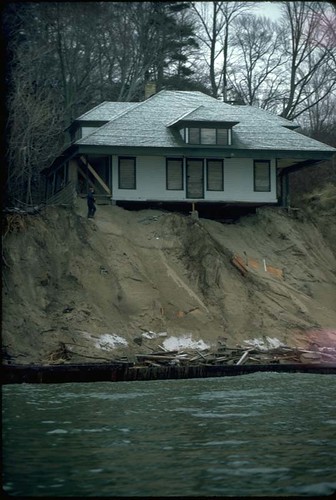

Homes along Lake Michigan are being damaged and completely demolished due to record high water levels this year. Powerful storms are destroying beaches, taking out staircases and decks, and ruining property values. This year, we saw the most destructive storm in over 30 years according to mLive (mlive.com, 2019). Unfortunately, this is part of living on the water.
Panicked residents have been requesting permits from the U.S. Army Corps of Engineers to install seawalls to try to protect their homes, however, the Michigan Department of Environment, Great Lakes, and Energy have been looking for better erosion solutions.
Effects of Shoreline Erosion
The effects of shoreline erosion on homeowners, wildlife, and public beaches this year have been much more visible. While shoreline erosion is expected, natural, and part of living in and around the Great Lakes, accelerated erosion can make life along the lakes extremely challenging.
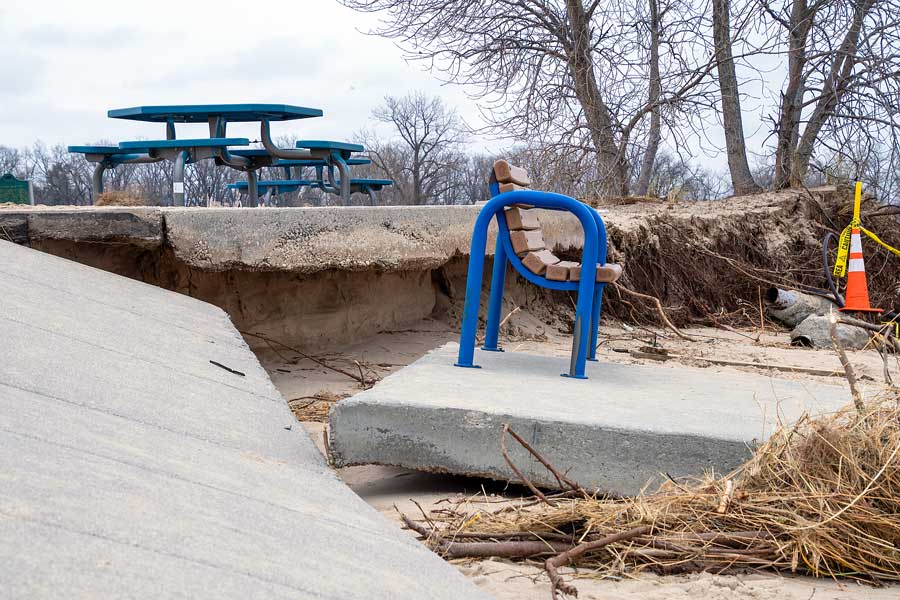

Shoreline Erosion Effects on Homeowners
We briefly discussed this quote from the Watershed Council in the introduction: “Given the high value of shoreline property, recession of just one foot of shore along a 100-foot lot can represent a loss of more than $9,000 on a cost-per-square-foot basis. This does not take into account the potential damage to, or loss of, near- shore buildings and other structures,” according to WatershedCouncil.org (Understanding, Living With, and Controlling Shoreline Erosion: A Guidebook for Shoreline Property Owners Third Edition).” It’s clear that erosion can not only cause financial problems for property owners, but can put them and their assets in danger.
Shoreline Erosion Effects on Wildlife
Natural Erosion is a part of life for aquatic wildlife and vegetation, however accelerated erosion due to vegetation removal, boats, and seawall installation can disturb the natural ecosystem in the Great Lakes and inland lakes in Michigan. Disruptions to ecosystems not only negatively affect the wildlife, but cause problems like cloudy water and algae overgrowth, which make the lake unpleasant for people too.
How to Prevent and Control Shoreline Erosion
There are some ways that you can protect your Great Lakes waterfront property without causing more harm to the natural environment. The Michigan Department of Environmental, Great Lakes, and Energy offers tons of great resources on the best ways to do so here. These resources outline what is and isn’t legal when it comes to erosion control. Be warned, this isn’t light reading. If you’re not sure where to start with this, we recommend consulting a professional team.
Seawalls
Seawalls are any type of hard “wall” structure, typically made of concrete or stone, installed along the shore to redirect wave energy and prevent the full force of waves from hitting the shore and causing natural erosion. While seawalls can temporarily stop natural shoreline erosion, they cause as many (or more) problems than they solve. Seawalls do not absorb wave energy, but instead, redirect it.
There are two paths wave energy usually takes after hitting a seawall. The first path is downward toward the lake bottom. When this happens, scouring also happens. As explained above, scouring is when redirected wave energy moves downward and “scoops” out the lake bottom. In addition to harming wildlife and their ecosystems, scouring makes the water deeper. Overtime the water becomes deep enough to undercut the seawall, rendering it ineffective.
Secondly, wave energy can also be directed at an angle, causing “wave flanking.” Wave flanking is when redirected wave energy moves toward neighboring properties. If one property installs a seawall, wave flanking will almost force neighbors to install seawalls, creating a vicious cycle of environmental damage and ineffective, short term erosion control. In short, seawalls create environmental problems and don’t work long term.
Rip Rap Rock Revetment
Rip Rap Rock is large rock used to help prevent shoreline erosion. While rip rap tends to be a pricier solution, it’s a great choice since it is long-term and environmentally friendly. Often, rocks naturally lie along shorelines and help control natural erosion by absorbing wave energy. However, many of these rocks are taken for use in upland landscaping. When these rocks are taken, erosion is accelerated. The concept of rip rap is essentially replacing or preserving these rocks. To create a rip rap rock revetment, rocks are stacked on the sloped lake or stream bottom up to the shore.
Unlike seawalls, rip rap revetments are long-lasting because they are quite flexible and adaptable. Should any damage occur, small fixes can get it back into top shape.
There are many regulations regarding size, type, and placement of stone that need to be adhered to in order to legally and safely install rip rap. There are many available sources, however, quite a bit of research is needed to become familiar with the topic.
Vegetation
Natural vegetation serves as a wonderful form of natural erosion control. When vegetation is removed, erosion is accelerated. Reestablishing this vegetation can help fix the problem. This technique is called Biotechnical Erosion Control or BEC. BEC is an inexpensive and fairly simple method of controlling erosion, however not many lakeshore property owners are interested in using it because vegetation can reduce water views. Property owners prefer the look of a grass lawn and misunderstand the limitations of the BEC technique. Landscape professionals should be able to use innovative and creative plans that allow for sweeping views, as well as functioning to protect the shoreline.
Depending on the level of erosion control that has to be established BEC can even be done DIY. BEC is advantageous because it is a long-term solution that doesn’t require very much maintenance.
Backfill for Shoreline Erosion
Backfill is not a shoreline erosion solution, although in some cases, it can support erosion control efforts. These instances are very rare. Backfill/beach fill can be the right solution if beach materials were excavated previously, or where the environmental impacts are minimal.
There are two main reasons for beach fills. The first is to establish a buffer to help control erosion. The second is to establish or enhance a beach for swimming and recreation. There are many problems with beach fill however. As explained by the Watershed Council: “filling is often a futile, environmentally destructive action and should only be pursued after careful study and planning. If a site is conducive to the long-term existence of sandy material, it would likely be there naturally. If it is not there, it is because the energy is either too great to allow it to remain in place, or not great enough to wash away the finer materials. In either case, sand fills on the littoral shelf of lakes often disappear in a relatively short time, either by washing away or simply sinking out of sight in a few years into the softer underlying sediments.”
Backfill is also usually required when installing a seawall. Superior Watersheds explains “most seawall projects require some amount of backfill. Should this be the case, locate a source of clean backfill material. In general, dredging for backfill should be avoided; finding an upland source is recommended” (superiorwatersheds.org, 2019). Dredging for backfill will cause more environmental damage on top of the damage caused by seawalls. Using an upland source will reduce the damage done.
Installing beach sand can also cause environmental issues: “Although a natural sand beach functions well at erosion control and is desirable to walk on, it is the least productive type of sediment from a biological aspect. The introduction of sand fill can bury otherwise productive aquatic habitats, such as gravel, rocks, weed beds, and organic deposits.” Where a natural sand beach already occurs, enhancing that beach may help with erosion control and will have minimal negative effects on the environment. However, installing beach sand incorrectly can lead to damage to the lake’s ecosystem.
Best Solutions for Lake Shoreline Erosion Control
According to the Michigan Department of Environmental Quality, the Michigan Shoreline Partnership, the Michigan Sea Grant, and the Michigan Department of Environment, Great Lakes, and Energy, the way that lakeshore and waterfront property owners handle their landscaping has a tremendous effect on the types of erosion they will face, as well as the impact on the natural environment. The lakeshores are naturally equipped to handle natural erosion because of vegetation and native barriers like rock. Relying on and reestablishing vegetation and native rock is an excellent, low-cost, long-term, and environmentally friendly way to protect and maintain lakeshore property.
If you own lakeshore property and are struggling with controlling erosion damage, the expert team at Superior Groundcover can help advise you on how to optimize your landscaping and establish an effective erosion control solution.
References
Michigan Natural Shoreline Partnership. (2019). Understanding Shorelines. [online] Available at: https://www.shorelinepartnership.org/erosion-at-the-shoreline.html [Accessed 26 Dec. 2019].
Michigan.gov. (2019). Living on the Coast. [online] Available at: https://www.michigan.gov/documents/deq/deq-wrd-greatlakes-Living_on_the_Coast_USACE-SeaGrant_615753_7.pdf [Accessed 26 Dec. 2019].
Michigan.gov. (2019). Natural Shorelines for Inland Lakes. [online] Available at: https://www.michigan.gov/documents/deq/wrd-natural-shorelines-inland-lakes_366530_7.pdf [Accessed 26 Dec. 2019].
Superiorwatersheds.org. (2019). Shoreline Protection for Inland Lakes. [online] Available at: https://superiorwatersheds.org/wp-content/uploads/2014/06/shorelineprotectionforinlandlakes.pdf [Accessed 26 Dec. 2019].
The Tip of the Mitt Watershed Council (2019). Understanding, Living With, & Controlling Shoreline Erosion A Guidebook for Shoreline Property Owners. 3rd ed. [ebook] Petoskey, MI: Jimmy F. New Foundation. Available at: https://www.watershedcouncil.org/uploads/7/2/5/1/7251350/shoreline_erosion_3rd_edition.pdf [Accessed 26 Dec. 2019].

